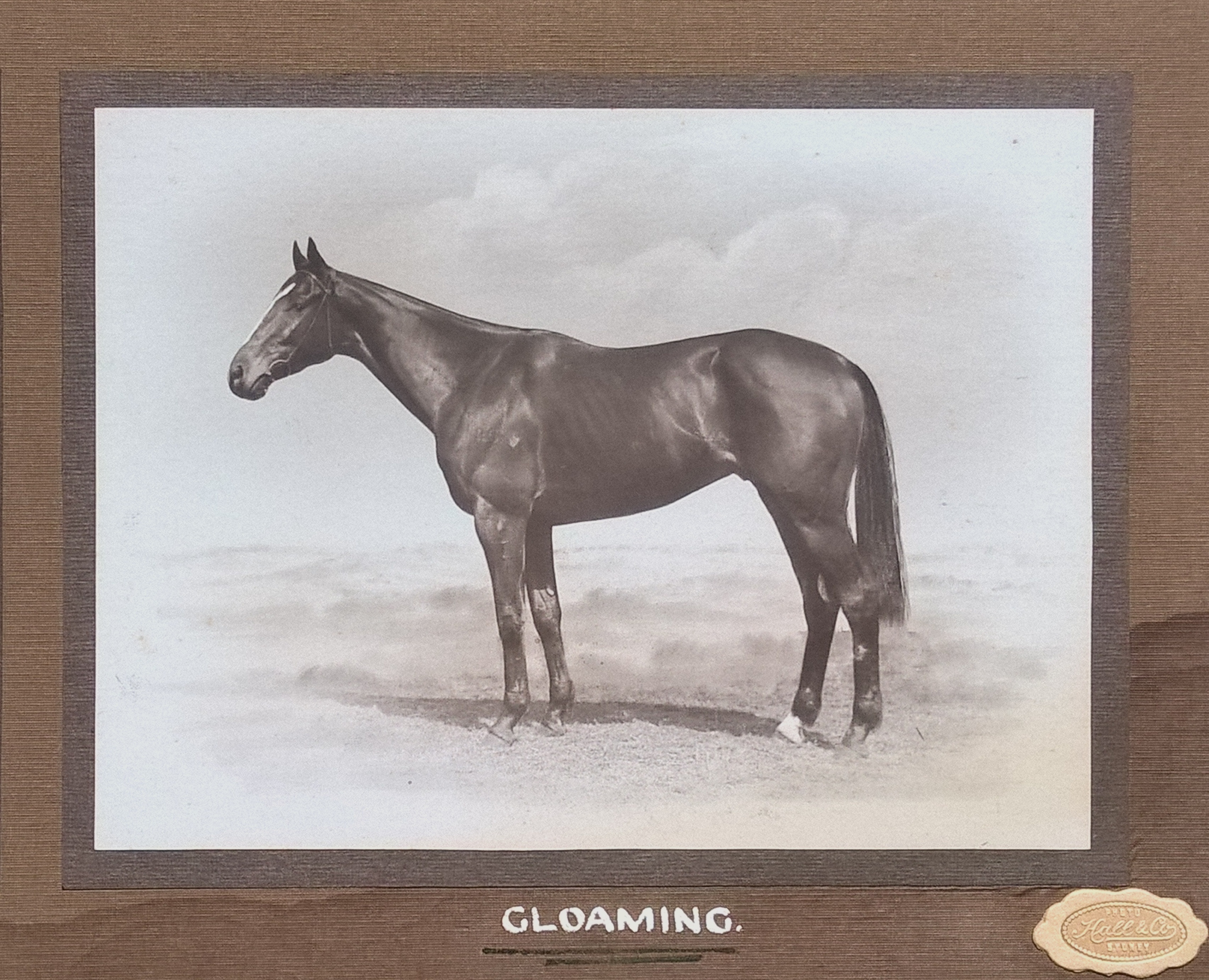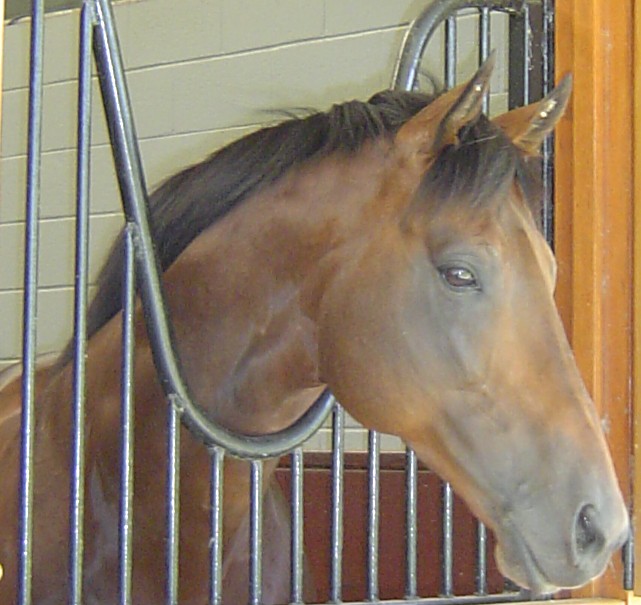|
Tidal Light
Tidal Light was a Thoroughbred racehorse who was the champion filly of her year and beat the colts in the 1987 New Zealand Derby. After finishing second in her debut, Tidal Light won ten of her next 13 races, including the Derby, Avondale Guineas, Waikato Guineas, Canterbury Guineas and a Group 1 victory in the Air New Zealand Stakes over older horses under weight-for-age conditions, beating the great Solveig. She was ridden in most of her 3 year old races by the 1986-87 champion apprentice, Michael Coleman. However, after winning the Avondale Guineas, Coleman broke a bone in his hand and was replaced by Grant Cooksley for Tidal Light's New Zealand Derby win. She returned in the spring of 1987 as a four-year-old, but failed to win a race and despite some good performances was obviously not the same horse she had been the previous season. Her three-year-old season earned her both the Three Year-Old of the Year award and Horse of the Year, a rare feat for a filly. Breeding ca ... [...More Info...] [...Related Items...] OR: [Wikipedia] [Google] [Baidu] |
New Zealand Derby
The New Zealand Derby is a set-weights Thoroughbred horse race for three-year-olds, run over a distance of 2,400 metres (12 furlongs) at Ellerslie Racecourse in Auckland, New Zealand. It is held in March each year. History The New Zealand Derby is an amalgamation of two races – the New Zealand Derby, run since 1860 at Riccarton, Christchurch; and the Great Northern Derby, run since 1875 at Ellerslie Racecourse in Auckland. The races were combined in 1973. Riccarton was awarded two 1,600 m races for three-year-olds in place of its Derby – the New Zealand 2000 Guineas and New Zealand 1000 Guineas. After its May debut, the New Zealand Derby was soon moved to New Year's Day, and then to Boxing Day. It continued to be run on this day for many years and became a popular traditional social occasion for Aucklanders until it was moved to the first day of the new Auckland Cup Week in March. The first March running of the Derby in 2006 was won by Wahid, from the stable of Allan Sharr ... [...More Info...] [...Related Items...] OR: [Wikipedia] [Google] [Baidu] |
Canterbury Guineas
The Randwick Guineas is an Australian Turf Club Group One Thoroughbred horse race for three-year-olds, run at set weights over a distance of 1600 metres at Randwick Racecourse in Sydney, Australia in March as a part of the Sydney Autumn Carnival. Total prize money for the race is A$1 million. History The winner of this race automatically qualifies for a berth in the Australian Derby and Doncaster Mile This race is the first leg of the Australian Three Year Old "Triple Crown" consisting of the Rosehill Guineas (2000 metres) and Australian Derby (2400 metres). Name This race replaced the former event Canterbury Guineas, which was discontinued after the 2005 running after the Australian Jockey Club and the Sydney Turf Club implemented major program changes streamlining the major races into the race calendar. As the Canterbury Guineas the race was originally run in the spring in early September but after 1978 the race was run early in the autumn as prep race for the rich Sydney c ... [...More Info...] [...Related Items...] OR: [Wikipedia] [Google] [Baidu] |
Thoroughbred
The Thoroughbred is a list of horse breeds, horse breed developed for Thoroughbred racing, horse racing. Although the word ''thoroughbred'' is sometimes used to refer to any breed of purebred horse, it technically refers only to the Thoroughbred breed. Thoroughbreds are considered "Hot-blooded horse, hot-blooded" horses that are known for their agility, speed, and spirit. The Thoroughbred, as it is known today, was developed in 17th- and 18th-century England, when native mares were Crossbreed, crossbred with imported stallion (horse), stallions of Arabian horse, Arabian, Barb horse, Barb, and Turkoman horse, Turkoman breeding. All modern Thoroughbreds can trace their pedigrees to three stallions originally imported into England in the 17th and 18th centuries, and to a larger number of foundation bloodstock, foundation mares of mostly English breeding. During the 18th and 19th centuries, the Thoroughbred breed spread throughout the world; they were imported into North America ... [...More Info...] [...Related Items...] OR: [Wikipedia] [Google] [Baidu] |
Racehorse
Horse racing is an equestrian performance activity, typically involving two or more horses ridden by jockeys (or sometimes driven without riders) over a set distance for competition. It is one of the most ancient of all sports, as its basic premise – to identify which of two or more horses is the fastest over a set course or distance – has been mostly unchanged since at least classical antiquity. Horse races vary widely in format, and many countries have developed their own particular traditions around the sport. Variations include restricting races to particular breeds, running over obstacles, running over different distances, running on different track surfaces, and running in different gaits. In some races, horses are assigned different weights to carry to reflect differences in ability, a process known as handicapping. While horses are sometimes raced purely for sport, a major part of horse racing's interest and economic importance is in the gambling associated ... [...More Info...] [...Related Items...] OR: [Wikipedia] [Google] [Baidu] |
Air New Zealand Stakes
The New Zealand Stakes, currently run as the Bonecrusher New Zealand Stakes, is a Group One thoroughbred horse race in New Zealand. It is run at Ellerslie Racecourse on Champions Day in March of every year, with a stake of $1 million.https://www.aucklandracing.co.nz/racedays/champions-day/ History The New Zealand Stakes was introduced as a weight-for-age race in the 1974/75 New Zealand racing season. It has been run under the following names depending on sponsors: * Second Century Stakes (1975–1976) * Air New Zealand Stakes (1977–1990) * Television New Zealand Stakes (1994) * Trackside Sales Stakes (1995–1996) * Harrah's Stakes (1997) * Lion Red Stakes (1999–2002) * Asian Racing Federation Stakes (2003) * Darley Stakes (2005) * Starcraft New Zealand Stakes (2006–2007) * First Sovereign Trust New Zealand Stakes (2008) * Sky City New Zealand Stakes (2009–2010) * Nicolas Feuillatte Stakes (2011) * Lindauer New Zealand Stakes (2012–2014) * Ronald McDonald House Cha ... [...More Info...] [...Related Items...] OR: [Wikipedia] [Google] [Baidu] |
Thoroughbred Racing In New Zealand
The racing of Thoroughbred horses (or gallopers, as they are also known) is a popular gaming and spectator sport and industry in New Zealand. History Thoroughbred horse racing commenced soon after European settlement. The first totalisator machine in the world was installed at Ellerslie Racecourse in 1913, (see Sir George Julius). Thoroughbred racing with the associated aspects such as horse breeding, training and care, race betting, race-day management and entertainment has gradually developed into an industry worth billions of dollars. The governing body is the New Zealand Thoroughbred Racing Incorporated. Race clubs and courses of New Zealand Thoroughbred racing is held throughout New Zealand, including courses in some of the smaller centres. Major Thoroughbred horse races in New Zealand Prominent people For further prominent people in New Zealand thoroughbred racing, see the list of honorees of the New Zealand Racing Hall of Fame. Leading jockeys Accordin ... [...More Info...] [...Related Items...] OR: [Wikipedia] [Google] [Baidu] |
1983 Racehorse Births
1983 saw both the official beginning of the Internet and the first mobile cellular telephone call. Events January * January 1 – The migration of the ARPANET to TCP/IP is officially completed (this is considered to be the beginning of the true Internet). * January 6 – Pope John Paul II appoints a bishop over the Czechoslovak exile community, which the ''Rudé právo'' newspaper calls a "provocation." This begins a year-long disagreement between the Czechoslovak Socialist Republic and the Vatican, leading to the eventual restoration of diplomatic relations between the two states. * January 14 – The head of Bangladesh's military dictatorship, Hussain Muhammad Ershad, announces his intentions to "turn Bangladesh into an Islamic state." * January 18 – U.S. Secretary of the Interior James G. Watt makes controversial remarks blaming poor living conditions on Native American reservations on "the failures of socialism." Watt will eventually resign in September after a series o ... [...More Info...] [...Related Items...] OR: [Wikipedia] [Google] [Baidu] |
2007 Racehorse Deaths
7 (seven) is the natural number following 6 and preceding 8. It is the only prime number preceding a cube. As an early prime number in the series of positive integers, the number seven has symbolic associations in religion, mythology, superstition and philosophy. The seven classical planets resulted in seven being the number of days in a week. 7 is often considered lucky in Western culture and is often seen as highly symbolic. Evolution of the Arabic digit For early Brahmi numerals, 7 was written more or less in one stroke as a curve that looks like an uppercase vertically inverted (ᒉ). The western Arab peoples' main contribution was to make the longer line diagonal rather than straight, though they showed some tendencies to making the digit more rectilinear. The eastern Arab peoples developed the digit from a form that looked something like 6 to one that looked like an uppercase V. Both modern Arab forms influenced the European form, a two-stroke form consisting of a ho ... [...More Info...] [...Related Items...] OR: [Wikipedia] [Google] [Baidu] |
Racehorses Bred In New Zealand
Horse racing is an equestrian performance activity, typically involving two or more horses ridden by jockeys (or sometimes driven without riders) over a set distance for competition. It is one of the most ancient of all sports, as its basic premise – to identify which of two or more horses is the fastest over a set course or distance – has been mostly unchanged since at least classical antiquity. Horse races vary widely in format, and many countries have developed their own particular traditions around the sport. Variations include restricting races to particular breeds, running over obstacles, running over different distances, running on different track surfaces, and running in different gaits. In some races, horses are assigned different weights to carry to reflect differences in ability, a process known as handicapping. While horses are sometimes raced purely for sport, a major part of horse racing's interest and economic importance is in the gambling associated w ... [...More Info...] [...Related Items...] OR: [Wikipedia] [Google] [Baidu] |
Racehorses Trained In New Zealand
Horse racing is an equestrian performance activity, typically involving two or more horses ridden by jockeys (or sometimes driven without riders) over a set distance for competition. It is one of the most ancient of all sports, as its basic premise – to identify which of two or more horses is the fastest over a set course or distance – has been mostly unchanged since at least classical antiquity. Horse races vary widely in format, and many countries have developed their own particular traditions around the sport. Variations include restricting races to particular breeds, running over obstacles, running over different distances, running on different track surfaces, and running in different gaits. In some races, horses are assigned different weights to carry to reflect differences in ability, a process known as handicapping. While horses are sometimes raced purely for sport, a major part of horse racing's interest and economic importance is in the gambling associated wit ... [...More Info...] [...Related Items...] OR: [Wikipedia] [Google] [Baidu] |





